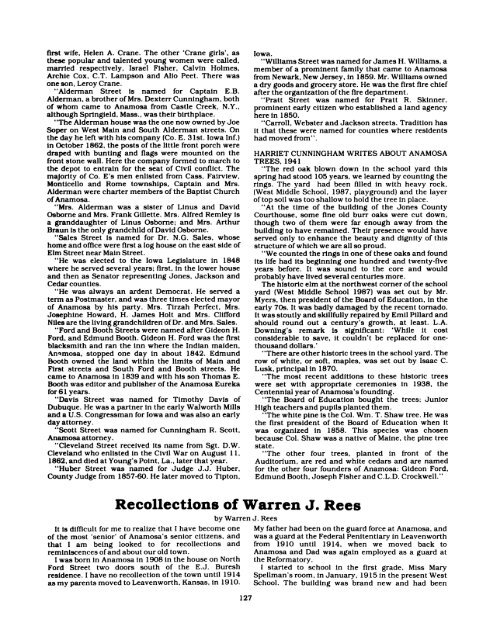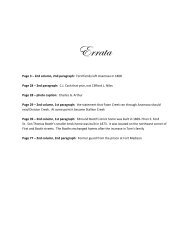Anamosa - A Reminiscence 1838 - 1988
The definitive history of the community of Anamosa, Iowa, USA
The definitive history of the community of Anamosa, Iowa, USA
You also want an ePaper? Increase the reach of your titles
YUMPU automatically turns print PDFs into web optimized ePapers that Google loves.
flrst wife. Helen A. Crane. The other ‘Crane girls‘, as<br />
these popular and talented young women were called.<br />
married respectively. Israel Fisher, Calvin Holmes.<br />
Archie Cox, C.T. Lampson and Alio Peet. There was<br />
one son, Leroy Crane.<br />
“Alderman Street is named for Captain E.B.<br />
Alderman, a brother of Mrs. Dexterr Cunningham, both<br />
of whom came to <strong>Anamosa</strong> from Castle Creek, N.Y.,<br />
although Springield, Mass., was their birthplace.<br />
“The Alderman house was the one now owned by Joe<br />
Soper on West Main and South Alderman streets. On<br />
the day he left with his company (Co. E. 31st. Iowa Inf.)<br />
in October 1862, the posts of the little front porch were<br />
draped with bunting and flags were mounted on the<br />
front stone wall. Here the company formed to march to<br />
the depot to entrain for the seat of Civil conflict. The<br />
majority of Co. E's men enlisted from Cass. Fairview.<br />
Monticello and Rome townships, Captain and Mrs.<br />
Alderman were charter members of the Baptist Church<br />
of <strong>Anamosa</strong>.<br />
"Mrs. Alderman was a sister of Linus and David<br />
Osborne and Mrs. Frank Gillette. Mrs. Alfred Remley is<br />
a granddaughter of Linus Osborne; and Mrs. Arthur<br />
Braun is the only grandchild of David Osborne.<br />
"Sales Street is named for Dr. N.G. Sales, whose<br />
home and office were first a log house on the east side of<br />
Elm Street near Main Street.<br />
“He was elected to the Iowa Legislature in 1848<br />
where he served several years; first, in the lower house<br />
and then as Senator representing Jones, Jackson and<br />
Cedar counties.<br />
“He was always an ardent Democrat. He served a<br />
term as Postmaster, and was three times elected mayor<br />
of <strong>Anamosa</strong> by his party. Mrs. Tirzah Perfect. Mrs.<br />
Josephine Howard, H. James Holt and Mrs. Clifford<br />
Niles are the living grandchildren of Dr. and Mrs. Sales.<br />
“Ford and Booth Streets were named after Gideon H.<br />
Ford, and Edmund Booth. Gideon H. Ford was the first<br />
blacksmith and ran the inn where the Indian maiden,<br />
<strong>Anamosa</strong>, stopped one day in about 1842. Edmund<br />
Booth owned the land within the limits of Main and<br />
First streets and South Ford and Booth streets. He<br />
came to <strong>Anamosa</strong> in 1839 and with his son Thomas E.<br />
Booth was editor and publisher of the <strong>Anamosa</strong> Eureka<br />
for 61 years.<br />
“Davis Street was named for Timothy Davis of<br />
Dubuque. He was a partner in the early Walworth Mills<br />
and a U.S. Congressman for Iowa and was also an early<br />
day attorney.<br />
"Scott Street was named for Cunningham R. Scott,<br />
<strong>Anamosa</strong> attorney.<br />
"Cleveland Street received its name from Sgt. D.W.<br />
Cleveland who enlisted in the Civil War on August I 1.<br />
1862, and died at Young's Point, La., later that year.<br />
“Huber Street was named for Judge J.J. Huber.<br />
County Judge from 1857-60. He later moved to Tipton.<br />
Iowa.<br />
“Williams Street was named for James H. Williams, a<br />
member of a prominent family that came to <strong>Anamosa</strong><br />
from Newark, New Jersey, in 1859. Mr. Williams owned<br />
a dry goods and grocery store. He was the first fire chief<br />
after the organization of the fire department.<br />
“Pratt Street was named for Pratt R. Skinner.<br />
prominent early citizen who established a land agency<br />
here in 1850.<br />
“Carroll, Webster and Jackson streets. Tradition has<br />
it that these were named for counties where residents<br />
had moved from‘ '.<br />
HARRIET CUNNINGHAM WRITES ABOUT ANAMOSA<br />
TREES. 1941<br />
"The red oak blown down in the school yard this<br />
spring had stood 105 years, we learned by counting the<br />
rings. The yard had been filled in with heavy rock.<br />
[West Middle School, 1987, playground) and the layer<br />
of top soil was too shallow to hold the tree in place.<br />
“At the time of the building of the Jones County<br />
Courthouse, some fine old burr oaks were cut down.<br />
though two of them were far enough away from the<br />
building to have remained. Their presence would have<br />
served only to enhance the beauty and dignity of this<br />
structure of which we are all so proud.<br />
"We counted the rings in one of these oaks ancl found<br />
its life had its beginning one hundred and twenty-five<br />
years before. It was sound to the core and would<br />
probably have lived several centuries more.<br />
The historic elm at the northwest corner of the school<br />
yard (West Middle School 1987) was set out by Mr.<br />
Myers, then president of the Board of Education, in the<br />
early 70s. It was badly damaged by the recent tomado.<br />
It was stoutly and skillfully repaired by Emil Pillard and<br />
should round out a century's growth, at least. L.A.<br />
Downing‘s remark is significant: ‘While it cost<br />
considerable to save, it couldn't be replaced for onethousand<br />
dollars.‘<br />
"There are other historic trees in the school yard. The<br />
row of white, or soft, maples, was set out by Isaac C.<br />
Lusk. principal in 1870.<br />
"The most recent additions to these historic trees<br />
were set with appropriate ceremonies in 1938, the<br />
Centennial year of <strong>Anamosa</strong>‘s founding.<br />
“The Board of Education bought the trees: Junior<br />
High teachers and pupils planted them.<br />
“The white pine is the Col. Wm. T. Shaw tree. He was<br />
the first president of the Board of Education when it<br />
was organized in 1858. This species was chosen<br />
because Col. Shaw was a native of Maine, the pine tree<br />
state.<br />
“The other four trees. planted in front of the<br />
Auditorium, are red and white cedars and are named<br />
for the other four founders of <strong>Anamosa</strong>: Gideon Ford,<br />
Edmund Booth, Joseph Fisher and C.L.D. Crockwell."<br />
Recollections of Warren J . Rees<br />
It is difficult for me to realize that I have become one<br />
of the most ‘senior’ of <strong>Anamosa</strong>‘s senior citizens, and<br />
that I am being looked to for recollections and<br />
reminiscences of and about our old town.<br />
I was born in <strong>Anamosa</strong> in 1908 in the house on North<br />
Ford Street two doors south of the E.J. Buresh<br />
residence. I have no recollection of the town until 1914<br />
as my parents moved to Leavenworth. Kansas, in 1910.<br />
by Warren J . Rees<br />
127<br />
My father had been on the guard force at <strong>Anamosa</strong>, and<br />
was a guard at the Federal Penitentiary in Leavenworth<br />
from I910 until 1914. when we moved back to<br />
<strong>Anamosa</strong> and Dad was again employed as a guard at<br />
the Reformatory.<br />
I started to school in the first grade. Miss Mary<br />
Spellman's room, in January, 1915 in the present West<br />
School. The building was brand new and had been



